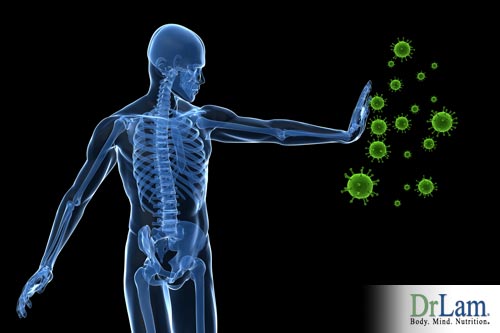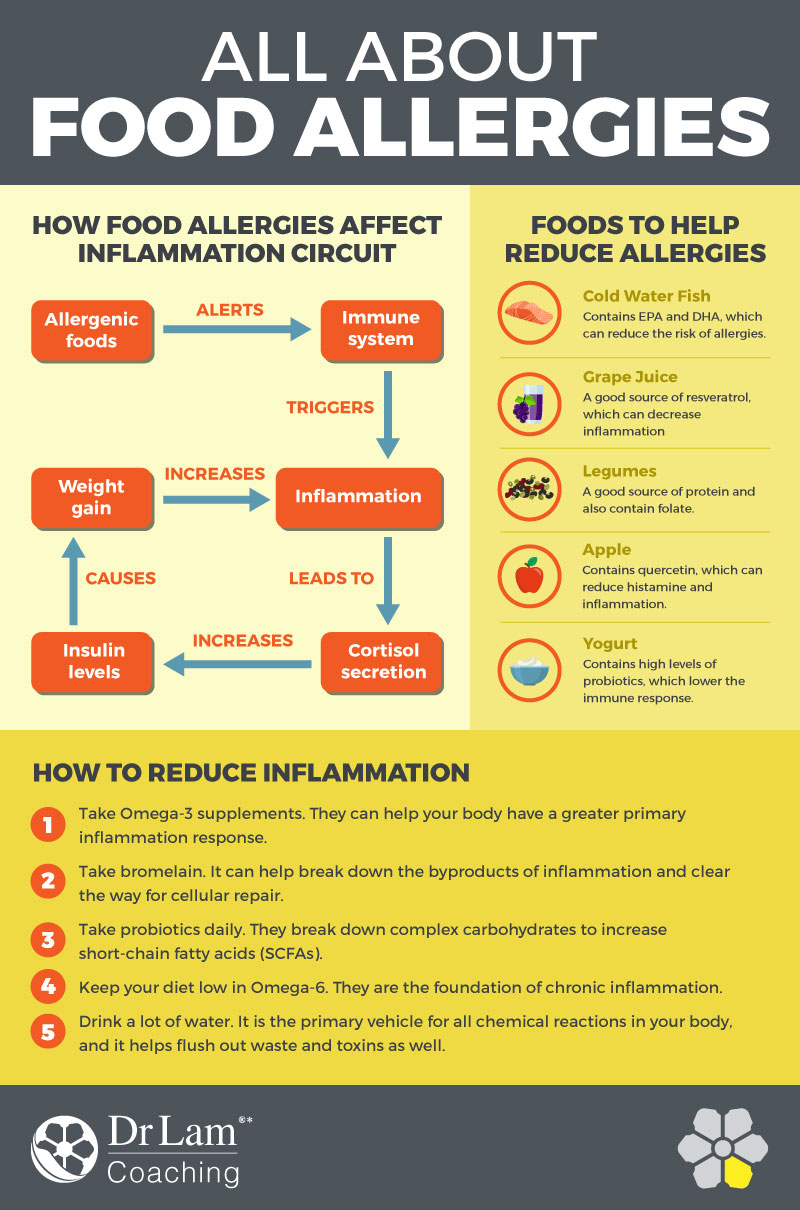 Food allergies seem to be on the increase in America. Nearly 1 in 13 children and over 9 million teens and adults have an allergic response to some kind of food. Peanuts are estimated to be the number one food that leads to allergic response, followed closely by tree nuts, fish, shellfish, soy, wheat, milk, and eggs. With this number of people allergic to foods, many people are in search of methods for reducing food allergies.
Food allergies seem to be on the increase in America. Nearly 1 in 13 children and over 9 million teens and adults have an allergic response to some kind of food. Peanuts are estimated to be the number one food that leads to allergic response, followed closely by tree nuts, fish, shellfish, soy, wheat, milk, and eggs. With this number of people allergic to foods, many people are in search of methods for reducing food allergies.
One of the first steps to take is to determine whether you genuinely have a food allergy or if your symptoms are caused by food intolerance. One of the major differences in these two conditions is the severity of symptoms.
A food allergy is a response to certain foods triggered by your immune system. In food intolerance, the immune system plays no part, even though the symptoms of the two conditions may be similar.
You must know the difference because if you have a food allergy, your symptoms can become very severe. In some cases, they may be fatal.
When you have a food allergy, the fragments of food responsible for your allergic response (allergens) are proteins that aren’t broken down by cooking or your digestive process. These allergens cross the gastrointestinal barrier, enter the bloodstream, and enter organs where they bring on symptoms. Your immune system recognizes these allergens as invaders and begins the process of trying to get rid of them.
Some of the most common food allergies are to peanuts and other tree nuts, shell fish, milk, and eggs. Any of these foods can bring a condition called anaphylaxis in which the airways constrict, and blood pressure can drop rapidly, sometimes becoming fatal if not dealt with immediately.
Many hope reducing food allergies can help avoid this situation.
With a food intolerance, you may have some of the same symptoms of an allergic reaction, such as nausea, cramps, vomiting, and diarrhea. However, you won’t be at risk for anaphylaxis. Also, you may be able to tolerate small amounts of the problem foods with no reaction, or the reaction could appear a day or two after eating the food.
One of the problems with dealing with a food intolerance is determining what exactly you are intolerant to. It could be to the food itself, food additives, something used in its preparation, or the way it is prepared. It may be that you don’t have enough of the enzymes needed to digest certain foods.
However, there is a lot of overlap between food allergies and food sensitivities, and one of the best ways to determine which you have is to see an allergist.
When considering ways of reducing food allergies, you need to be aware of the role of the immune system. The entire purpose of the immune system is to protect your body from foreign substances that can cause illness and infection. It’s made up of a complex network of cells and organs that seek out and destroy bacteria, viruses, fungi, and other infectious microorganisms that would damage your body.
 Most of the time, this process works well. It recognizes cells that are threatening and those that are harmless. Unfortunately, sometimes the immune systems of some people identify certain food particles as foreign cell invaders, as threats, and begins the process of destroying them.
Most of the time, this process works well. It recognizes cells that are threatening and those that are harmless. Unfortunately, sometimes the immune systems of some people identify certain food particles as foreign cell invaders, as threats, and begins the process of destroying them.
There are two features of the immune response involved in food allergies. One is the development of immunoglobulin E (IgE), a protein antibody circulating in the blood. The other main feature of immune response is mast cell activation. These cells are prevalent in all body tissues but are more frequently found in the nose, throat, lungs, skin, and GI tract.
When a person develops IgE as an antibody toward something as harmless as food, there typically is a genetic background responsible. Someone in their family lineage had allergies to something, not necessarily food. A person with both parents having allergies is more likely to develop allergies than someone with only one allergic parent.
When a person who has a food allergy is exposed to a problem food, this food triggers cells to produce large amounts of IgE during the digestion process. When the IgE is released, it attaches to mast cells. The next time you eat that food, the IgE cells developed against it will trigger the release of chemicals like histamine that then bring on allergy symptoms. Depending on the location of the mast cells to which the IgE attached, your symptoms may be in your ears, nose, or throat; in your skin; or in your GI tract.
The food allergens can travel to various parts of your body after they cross the GI barrier and get into your bloodstream. As they travel, you may experience symptoms in different parts of your body. From itching in your mouth as you chew the food, to GI symptoms during digestion, to a drop in blood pressure as the allergens travel through your blood, to hives when they get to the skin, to wheezing in the lungs. It only takes from minutes to an hour for these symptoms to appear.
Reducing inflammation also plays an important role in reducing food allergies.
When you eat foods that bring on an allergic response, the immune system is alerted to the presence of what it considers invaders. One of the tools the immune system brings to the fight is inflammation. The inflammation that is triggered leads to the adrenal glands secreting cortisol and other hormones that negatively affect blood sugar and insulin levels. High insulin levels trigger enzymes that cause you to gain weight by depositing fat cells rather than burning them for energy. If you have adrenal fatigue as well as food allergies, this weight will likely be around the middle of the body.
Through this mechanism, food allergies can lead to significant weight gain, stored as adipose tissue, or fat. Then the adipose tissue will itself lead to increased inflammation creating a vicious cycle.
If you gain more weight, the fat cells accumulating around the body become larger. At some point, they begin leaking, and the immune system releases macrophages to clean up the leakage. The pro-inflammatory chemicals left behind by the macrophages lead to many of the chronic health problems of the overweight.
 Stress, such as that which triggers Adrenal Fatigue Syndrome (AFS), can also cause more inflammation. It leads to the release of cortisol by the adrenal glands. Cortisol is the stress-fighting hormone that aids your body in dealing with the damage caused by stress. When cortisol levels are high, the hormone can break down the lining of the intestine. This makes you more likely to have bacteria, yeasts, fungi, and viruses cross the protective barrier of the intestine and lead to more inflammation. If stress continues, cortisol levels drop because of adrenal exhaustion, and you become more and more ill.
Stress, such as that which triggers Adrenal Fatigue Syndrome (AFS), can also cause more inflammation. It leads to the release of cortisol by the adrenal glands. Cortisol is the stress-fighting hormone that aids your body in dealing with the damage caused by stress. When cortisol levels are high, the hormone can break down the lining of the intestine. This makes you more likely to have bacteria, yeasts, fungi, and viruses cross the protective barrier of the intestine and lead to more inflammation. If stress continues, cortisol levels drop because of adrenal exhaustion, and you become more and more ill.
Sometimes health care professionals have difficulty deciding whether your symptoms are due to food allergies or something else. AFS is a common and pervasive problem with many symptoms, which he or she is not trained to spot. You will likely be directed towards a method of reducing food allergies, such as avoiding problem foods.
Only a professional trained in the NeuroEndoMetabolic (NEM) model of stress response will know to look for the interrelationship of symptoms in the six circuits of your body. With the possibility of food allergies contributing to your condition, the metabolic response will be the one most affected. The inflammatory circuit is also triggered. Knowing and following this NEM model will allow your healthcare professional to get to the root cause of your symptoms and devise remediation efforts that will best deal with your condition.
Continuing stress also limits your body’s ability to produce the enzymes and hydrochloric acid needed for appropriate digestion. Likewise, the constant hurrying and rushing so common in our stress-ridden culture interferes with proper digestion.
The best way to assure good digestion is to eat meals in a slow, restful fashion, rather than grabbing something on the way to the next meeting. Poorly digested protein literally rots in your stomach and intestines, leading to more stomach upset.
Any discussion of ways of reducing food allergies must also include information about the role of histamine. When you have a food allergy, the body releases histamine, which brings on the symptoms of allergic reaction. Histamine is a naturally occurring protein that is involved in the immune system’s response to invaders of the body. It aids in regulating your gut function, and it is a neurotransmitter as well.
All cells of the body contain histamine, as well as many foods you eat. It plays a major role in your immune system and in inflammation. The symptoms you experience when you eat foods you’re allergic to depend on where histamine is released and the receptors it binds to. It can affect your respiratory system, cardiovascular system, GI system, or your skin.
Allergy symptoms depend on where histamine is released. If it is released in the ears, nose, and throat, you’ll likely feel an itchy sensation in your nose and throat, or you may have trouble swallowing or breathing. If it’s released in the GI tract, you might have stomach cramps, diarrhea, or pain. If it’s released in the skin system, you may develop hives. At times, you may experience a combination of symptoms as you consume and digest the food particles.
 The most common method of reducing food allergies is to avoid eating the foods that bring on problems altogether. This method focuses on removing what causes your symptoms, rather than reducing the severity of your reaction. There are no medications to prevent food allergies, although allergy shots can provide relief for some types of allergies.
The most common method of reducing food allergies is to avoid eating the foods that bring on problems altogether. This method focuses on removing what causes your symptoms, rather than reducing the severity of your reaction. There are no medications to prevent food allergies, although allergy shots can provide relief for some types of allergies.
Once you and your healthcare professional have determined which foods lead to an allergic response, you have to get them out of your diet. This requires you to read food labels in the grocery store to be sure nothing will lead to an allergic response. Many prepared foods contain unlikely allergens like wheat or soy. U.S. law requires food manufacturers to list in plain language any of the most common products they use that might lead to an allergic response.

No diet will eliminate your allergic response to foods, but some foods may help in reducing food allergy responses. The foods discussed below may decrease the inflammation that plays such a major role in the allergic response.
Cold Water Fish. These fish contain eicosapentaenoic acid (EPA) and docosahexaenoic acid (DHA), which are two Omega-3 fatty acids that can reduce the risk of allergies. Salmon and fish like trout and tuna are a good choice in this category. Some possible side effects of ingesting Omega-3 include a fishy taste in your mouth, stomach upset, loose stools, and nausea. If you take more than 3 grams of this fish oil per day, you may increase your risk of bleeding.
Grape Juice. This is a good source of resveratrol, an antioxidant that has been shown to decrease the inflammation found in asthma in animal studies. You must be aware that resveratrol might increase the risk of bleeding due to slowing blood clotting. Also, resveratrol can act like estrogen, so if you have a cancer that is hormone-sensitive, you should probably avoid resveratrol.
Legumes. A good source of protein, beans and other legumes may be a good substitute for meat, which has been shown to increase inflammation. Legumes also contain folate, which appears to reduce the impact of immune system responses to common allergens.
Apples. This fruit contains quercetin, a substance that has been shown to reduce histamine and inflammation. If you are pregnant or breastfeeding, you should avoid quercetin due to the lack of information regarding its use in these conditions.
Yogurt. Yogurt contains high levels of probiotics that have been shown to lower the immune response. Use caution when consuming probiotics. Most of the side effects are mild, but rarely some more serious side effects such as infection have occurred. Occasionally overstimulation of the immune system can result.
A large part of your attempts at reducing food allergies will be directed at reducing inflammation.
Taking Omega-3 supplements may help in reducing inflammation. The main pathway to inflammation is made of Omega-3 fatty acids. Taking more of this substance can help your body have a greater primary inflammation response and decrease the risk of developing the long-term, low-level inflammation that leads to chronic conditions. So, one part of your plan for reducing food allergies may include adding Omega-3 supplements.
 Plant enzymes that contain bromelain can help break down the byproducts of inflammation and clear the way for cellular repair. Because bromelain can also increase the impact of allergies, be sure to consult with your healthcare professional before taking bromelain. Pregnant or breastfeeding women should avoid bromelain supplements, although pineapple is fine.
Plant enzymes that contain bromelain can help break down the byproducts of inflammation and clear the way for cellular repair. Because bromelain can also increase the impact of allergies, be sure to consult with your healthcare professional before taking bromelain. Pregnant or breastfeeding women should avoid bromelain supplements, although pineapple is fine.
Taking probiotics daily will also help deal with inflammation. Probiotics in the intestine break down complex carbohydrates to increase short-chain fatty acids (SCFAs). Your immune system is fed by SCFAs. A well-functioning immune system leads to more efficient inflammation and less chronic inflammation.
Keeping your diet low in Omega-6 should also be a major part of your attempts at reducing food allergies. The standard American diet is composed of many foods containing Omega-6 fatty acids which are the foundation of chronic inflammation. They also prompt the immune system to go around primary inflammation and directly to chronic inflammation.
Drink a lot of water daily. Water is the primary vehicle for all chemical reactions in your body, and it helps flush out waste and toxins as well.
Overall, priming your body to have a more effective initial inflammatory response can help it avoid the chronic, low-level inflammation that leads to other issues like AFS.
Building tolerance to allergens may be a significant part of your attempt at reducing food allergies.
Several factors determine the development of tolerance. Form and dose of the allergen, and your genetic background, normal gut flora, and age are all factors.
Taking allergens in soluble, low-doses seems to be the best form for increasing tolerance. Soluble form antigens are more amenable to tolerance than those in particulate form. High doses of antigen tend to increase the allergic response. Low doses, even very low doses, may lead to a suppressive pathway to tolerance through T-cells.
The role of genetics is not clearly understood at this time, although HLA class-II genotypes appear to be more frequent in people with peanut allergies.The role of normal gut flora appears to have some effect on tolerance efforts. Your age has been shown to affect tolerance efforts, also. Generally, the younger you are when tolerance efforts are started, the better.
Current research into methods of increasing tolerance shows promising results. In considering this research, the difference between tolerance and desensitization must be considered. Desensitization is a more temporary situation where the body does not respond to the allergen, which reverts back to an allergic response when the regular administration of the allergen is stopped. The aim of current research is to gain tolerance, a more permanent non-reactive state.
Healing the gut is necessary for reducing food allergies. This helps stop food particles from leaking into the bloodstream where they are misidentified as invaders. Fortunately, there are several things that can be done to help heal the gut from the damage that leads to food allergies.
The first step is to avoid foods that increase inflammation and carry toxins that damage your gut. These can include refined sugars, grains, gluten, processed foods, GMO foods, foods high in pesticides, and dairy, especially if you suspect you have an intolerance. Also, avoid NSAIDs and antibiotics unless your doctor recommends them.
 Next, take steps to reduce your stress load. Chronic stress damages the gut, leading to more immune response and increased inflammation. Learn to relax, get more sleep, meditate, practice yoga, and take more walks. Look at your life and see where the stress originates to see what you need to do to make beneficial changes.
Next, take steps to reduce your stress load. Chronic stress damages the gut, leading to more immune response and increased inflammation. Learn to relax, get more sleep, meditate, practice yoga, and take more walks. Look at your life and see where the stress originates to see what you need to do to make beneficial changes.
Some supplements can also help heal the gut. L-glutamine is possibly the most necessary of these supplements. It plays a major role in healing your gut. This amino acid strengthens the walls of the gut by nourishing the epithelial cells that line both the large and small intestine. Probiotics, digestive enzymes, and mineral supplements from plants can also aid in healing.
These and other methods can help heal your gut and allow you to live better.
Ultimately, to make sure you don’t have an allergic reaction to food, you have to remove that food from your diet. However, by ensuring your body has the right nutritional support to reduce chronic inflammation, stress, and leaky gut, you can give yourself a better chance of reducing food allergies. The response may never go away, but through slow, gradual steps in consultation with your doctor, better health is possible.
Reducing food allergies requires knowing what you’re allergic to. Avoiding those foods is the only satisfactory way to avoid a response. Healing your gut and reducing inflammation can help to decrease the impact of the allergies, and eating certain foods such as salmon, legumes, and yogurt can also help.